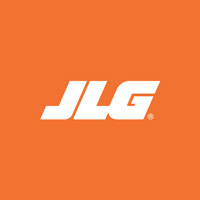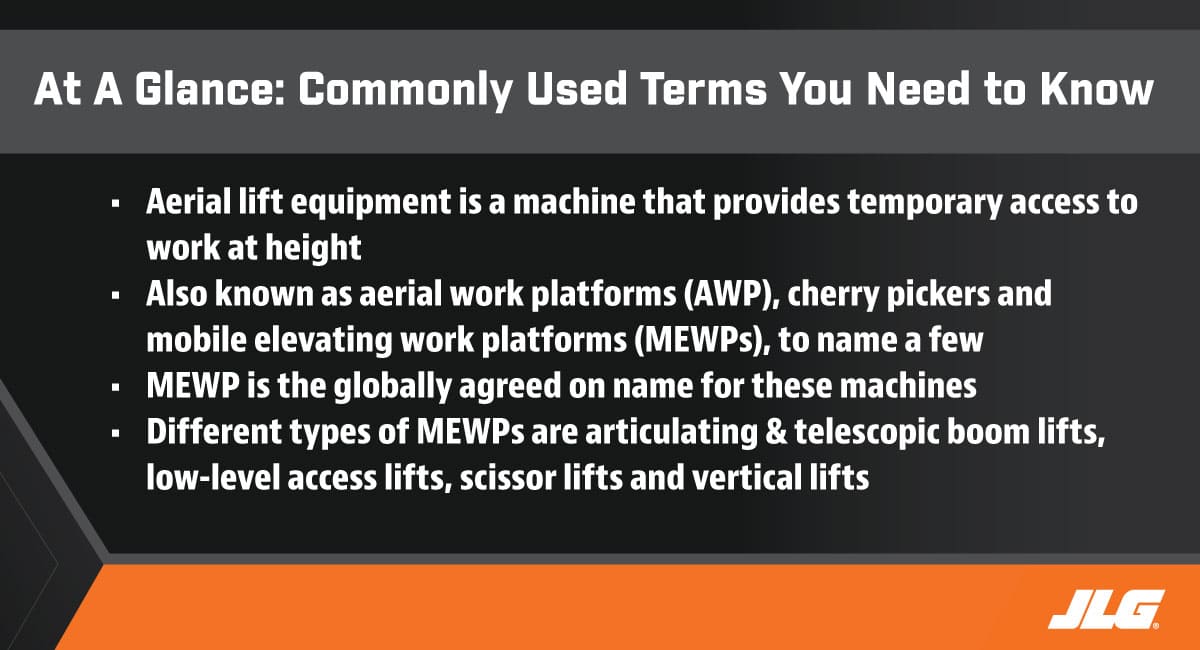 Logan Cunningham
Logan Cunningham
Product Training Specialist
____
JLG Industries
If you are new to the access industry, learning the lingo of the aerial equipment market is important to safely, and productively, working with this type of equipment. You don’t have to be an expert, but it does help to have an understanding of the basics.
Let’s start out first by defining aerial lift equipment: ANSI (the American National Standards Institute) defines a Mobile Elevating Work Platform (MEWP) as a machine/device intended for moving persons, tools and material to working positions, consisting of at least a work platform with controls, an extending structure and a chassis. Globally, MEWP is the term most commonly used to refer to these machines, but they are referred to by many other names, including aerial (or access) platforms, aerial work platforms (AWP), cherry pickers, elevating work platforms (EWP) and lift platforms.
There are several different classifications of MEWPs available to get work done at height, including boom lifts (articulating, straight or telescopic, crawler, electric & hybrid and towable), low-level access lifts, scissor lifts, stock pickers (also known as order pickers) and vertical lifts.
*It is important to know that telehandlers are not considered a MEWP; they are classified by OSHA as a Class 7 rough-terrain forklift*

Now that you know what a MEWP is, it is important to quickly learn the lingo the access industry relates to these machines. Below is a list of common terms associated with MEWPs that are important for you to know:
Floor Pressure – Also known as floor load, it is the weight the floor is capable of sustaining, measured in pounds per square foot (PSF).
Gradeability – The percent of grade of the incline the machine can climb (front to rear).
Ground Control Panel – The control panel that allows the machine functions to be operated from the ground. Ground controls operate all functions except drive and steer. The ground controls can also override the platform controls.
Ground Bearing Pressure – The pressure exerted on the ground by a machine’s tires or tracks, measured in pounds per square inch (PSI).
Load Capacity – The amount of weight the machine’s platform is rated to hold, lift and/or carry safely during machine operation.
Machine Height –The maximum height of the machine in stowed position.
Machine Width – The maximum width of the machine in stowed position.
Machine Length – The maximum length of the machine in stowed position.
Manually Operated – Machines operated by hand.
Manually Propelled – Machines that must be physically pushed or pulled to move.
Oscillating Axle – Axles that pivot, keeping the tires on the ground and compensating for uneven terrain during operation.
Outriggers – Hydraulic or manual devices that, when deployed, increase the stability of the machine by creating a wider footprint, as well as by lifting and leveling.
Platform Control Panel – The control panel in the machine’s platform. Platform controls operate all functions.
Platform Height – The maximum vertical distance the machine’s platform is capable of extending, measured from ground level to the platform floor.
Restricted Platform Capacity – Weight restrictions within a machine’s working envelope usually shorter boom lengths and higher boom angles.
Self-Propelled – Machines that can be driven.
Sideslope – The angle of the slope the machine can be driven across (left to right).
Stabilizers – Devices deployed to increase the stability of the machine (not capable of lifting or leveling the machine).
Tailswing – When a lift is rotated, this occurs if the rear end of the turntable extends beyond any edge of the drive chassis.
Travel Speed – The maximum speed that a machine can go.
Turning Radius – The circle that the out-most tire follows when the machine is turned in the smallest possible circle.
Working Envelope – The entire working area that a lift is able to extend and reach.
Working Height – Platform height plus 6 ft (1.82 m) to account for an operator’s overhead reach.
Working Width – The maximum width of the machine with the outriggers deployed.
Unrestricted Platform Capacity – The weight capacity of the machine’s platform for the machine’s entire working envelope.
Want to learn more? JLG® training can provide you with the information you need to know about the aerial industry, bringing safety and confidence to your team. From supervisor training to MEWP and telehandler operator and equipment service training, JLG offers comprehensive training programs developed by industry experts to meet all your needs. To learn more about JLG training options, click here.
To access additional tools, reference materials and resources from JLG that can help you get your job done safely and more effectively, visit here.
Want to stay up to date with industry news and trends similar to this? Make sure you subscribe below to receive monthly updates from Direct Access with newly posted content so you never miss important information.